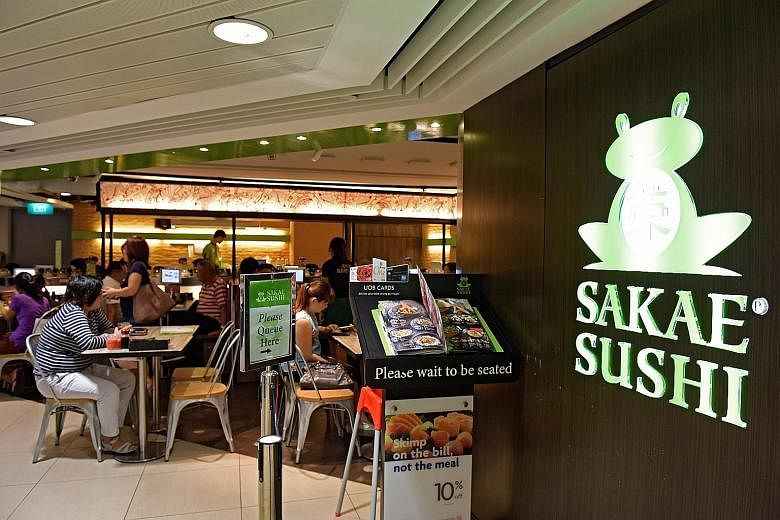Last week, Singapore-listed Sakae Holdings finally caught a break in its long-time fight with former director Andy Ong, when the High Court ruled in its favour and found that Mr Ong did breach his fiduciary duties to the firm.
That was a major victory for the operator of the Sakae Sushi chain as the four-year legal battle had taken a toll on the business as well as its management.
Over the years, Sakae's fortunes have waned. Not only was it mired in the court fight, but the company has also had to wrestle with flagging results over the past two financial years.
Rising legal fees, among other things, pushed the company into a loss of $4.6 million for financial year 2015, from a net profit of $2.1 million in 2014. Its net losses widened further last year to $13.1 million.
The environment that Sakae now operates in is far more challenging compared with the days when it took the nation by storm with its conveyor-belt sushi and interactive computer menus. It set up its first restaurant in 1997 amid the Asian financial crisis.
At the time, the Sakae Sushi chain symbolised all that was right with the food and beverage sector in Singapore - a quick-service concept offering a fun-filled, value-for- money dining experience.
It invested in staff training and went global. At its peak, it had more than 200 restaurants in Singapore and the region.
-
$13.1m
Net losses of Sakae Holdings last year.
-
$4.6m
Net loss of Sakae Holdings for financial year 2015.
This year, it will launch up to three restaurants in Myanmar, add two in Vietnam and is considering re-entering the Indonesian market.
But amid its ambitious regional expansion, Sakae is undergoing its biggest restructuring in Singapore.
RESTRUCTURING TO GET FITTER
The company has shuttered 10 of 46 restaurants here in recent months, and plans to cut six more by the first half of this year, as it wrestles with rising business costs and fierce competition in the F&B sector.
While it has not retrenched staff, the company has relocated workers from closed restaurants to other locations, and is not replacing those who have resigned.
"We are working very hard to boost morale, while going through rationalisation to get ourselves fitter," Sakae founder Douglas Foo told The Straits Times.
Concurrently, Sakae has been moving into advisory work to build the financial resources needed to expand in the region, and that is part of Mr Foo's grand plan to grow the chain to 30,000 outlets worldwide.
The restaurant business model is not going to offer much scale, especially as its Singapore operations are being restructured, he said.
BRAND INNOVATION
But consultants point to branding issues that Sakae should consider addressing, in particular, perceptions that its business has failed to evolve in response to changing demands and tastes, and these have left it in a position where downsizing in Singapore and looking to other emerging markets for growth is the only viable short-term strategy.
More thought should be given to Sakae's brand, and what distinguishes its offerings from those of other F&B operators here, they say.
Mr Nick Foley, president for South-east Asia, Pacific and Japan at brand consultancy Landor, said: "If Nike is about 'winning', Disney is about 'magic', and Red Bull is about 'extreme energy', what is the single concept that makes Sakae desirable and distinctive?"
Mr Graham Hitchmough, chief executive for Asia-Pacific at Brand Union, said that reviving the brand's mojo is important - some long-time customers miss little touches such as tablet-based games for children and also noticed that Sakae's menu has been changed around significantly but not always for the better.
While chains such as Sushi Tei present a slick, contemporary Japanese dining experience and high-end izakaya joints focus on quality and seasonality, he said "those that succeed tend to share key characteristics: a sense of authenticity around the core offer, as well as consistent product and service".
FOOD SAFETY FOCUS
But innovation is part of Sakae's DNA, as well as food safety, Mr Foo countered.
He said: "A lot of restaurants depend on food-trading companies. But they don't have a clear picture where their food supply is coming from, or its quality. Food safety is our key promise. We work very closely with farms to ensure this. I visit the farms myself, see how they farm and take the water where the fish are swimming for lab tests.
"We also check their fish feed. What has the fish been eating for the past three years? Is it done in a sustainable way so we can maintain consistent supply?
"The way we built our business is different from that of ordinary restaurant operators."
So dedicated is Mr Foo to maintaining food safety and quality that he took a pay cut for half a year during the Sars outbreak in Singapore so that the restaurants can continue to include vitamin E in their sushi rice, rather than cut costs.
"Had we taken the vitamin E out, it would have compromised food safety and our brand," he said.
He added that his colleagues are always experimenting with new food creations and experiences. "Some of our new creations are accepted, some not. But no matter what new items we add, some fundamental staples like salmon sushi and inari sushi are still hot favourites."
Dr Lau Kong Cheen, senior director at brand consultancy A.S. Louken, said that diversifying into corporate advisory and food trading and expanding into new markets overseas are good moves.
"Sakae was a brand highly relevant when Japanese cuisine was on the rise, but it is slowly losing its brand relevance to certain market segments that are more sophisticated, well travelled, or just more budget-conscious.
"But there are fertile markets beyond Singapore that are more attractive, and they can leverage a brand that has been strongly established here," Dr Lau said.
LEGAL WOES
But building the Sakae brand has not been easy as Mr Foo has been fighting Mr Ong, who had been a close friend since their national service days, in court. Their friendship ended in tatters after Mr Ong invited Mr Foo to participate in a property development investment with him. The ensuing legal battle has "hugely impacted how the company performed" and drained almost $10 million in legal fees in the past four years, Mr Foo said.
"It took away our chief financial officer's management time, and the administration and finance division had to help trace documents, put out filings. That was time we could have taken to build the business. And I had to sit on the witness stand... for two weeks in February last year during trial.
"That was not a nice experience. But I wanted to do nothing but tell the truth," Mr Foo said.
But there is light at the end of the tunnel as a High Court judge ruled in Sakae's favour last week. Justice Judith Prakash ordered Mr Ong and associates Ong Han Boon and Ho Yew Kong to pay about $35 million to Griffin Real Estate Investment Holdings, in which Sakae is a minority shareholder.
Mr Ong was also ordered to pay $2.64 million to Sakae.
Sakae on Thursday said it will hold its annual general meeting on June 30 instead of April 30, as its auditors need time to assess the judgment's impact on its earnings this year.
"The judgment is justice for the 80-plus minor shareholders of Griffin Real Estate who will get part of the $35 million," Mr Foo said. "We will be concentrating more on our business now rather than channelling energy on the suit."
He added: "This is one of the saddest things to happen in my life journey. It did drain a lot of our financial resources and management time. But I take responsibility in that there are things we needed to be mindful of. I am saddened and disappointed over the loss of the friendship, but life has to go on."


